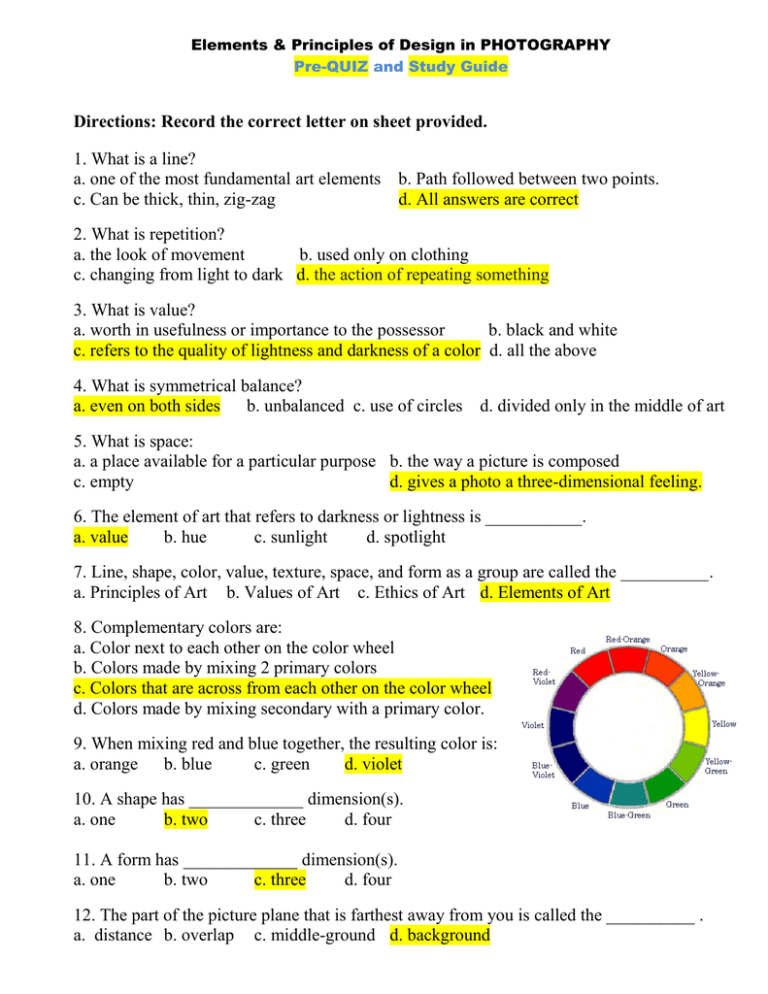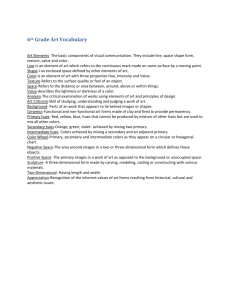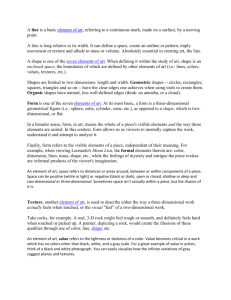Directions: Record the correct letter on sheet provided. 1. What is a
advertisement

Elements & Principles of Design in PHOTOGRAPHY Pre-QUIZ and Study Guide Directions: Record the correct letter on sheet provided. 1. What is a line? a. one of the most fundamental art elements b. Path followed between two points. c. Can be thick, thin, zig-zag d. All answers are correct 2. What is repetition? a. the look of movement b. used only on clothing c. changing from light to dark d. the action of repeating something 3. What is value? a. worth in usefulness or importance to the possessor b. black and white c. refers to the quality of lightness and darkness of a color d. all the above 4. What is symmetrical balance? a. even on both sides b. unbalanced c. use of circles d. divided only in the middle of art 5. What is space: a. a place available for a particular purpose b. the way a picture is composed c. empty d. gives a photo a three-dimensional feeling. 6. The element of art that refers to darkness or lightness is ___________. a. value b. hue c. sunlight d. spotlight 7. Line, shape, color, value, texture, space, and form as a group are called the __________. a. Principles of Art b. Values of Art c. Ethics of Art d. Elements of Art 8. Complementary colors are: a. Color next to each other on the color wheel b. Colors made by mixing 2 primary colors c. Colors that are across from each other on the color wheel d. Colors made by mixing secondary with a primary color. 9. When mixing red and blue together, the resulting color is: a. orange b. blue c. green d. violet 10. A shape has _____________ dimension(s). a. one b. two c. three d. four 11. A form has _____________ dimension(s). a. one b. two c. three d. four 12. The part of the picture plane that is farthest away from you is called the __________ . a. distance b. overlap c. middle-ground d. background 13. In two- and three-dimensional art, the space between and around shapes and forms is the ____________. a. picture plane b. positive space c. negative space d. background 14. The area between, around, above, below and within an object is a definition of _______. a. space b. picture plane c. shape d. background 15. A shape which can be defined by a mathematical formula and which is called a _____________. a. irregular b. organic c. geometric d. algebraic 16. A form or shape that is very irregular and uneven is called: a. regular b. organic c. geometric d. linear 17. When you can see slick, smooth, rough, velvety, satiny, bumpy, in a photograph. a. implied texture b. line c. value d. contrast 18. The center-of-interest, which might be the largest, brightest, or lightest subject. a. contrast b. emphasis c. repetition d. unity 19. A shape is an area enclosed by an outline. a. space b. form c. 2-D d. 3-D 20. A form has height, width, and depth. a. 3-D b. shape c. space d. 2-D Directions: Write down True or False next to the number on your sheet. 21. There are five kinds of lines: straight, curved, horizontal, vertical, and combination. TRUE or FALSE 22. Are shape and form similar to each other? TRUE or FALSE 23. Texture makes a photograph look real and suggest its three-dimensional, rather than the two-dimensional object that it actually is. TRUE or FALSE 24. The Principles of Design are: balance, unity, variety, movement, rhythm, emphasis, proportion, and pattern. TRUE or FALSE 25. Composition refers to the arrangement and relationship of the similar parts that make up the whole image. TRUE or FALSE Label using Elements and Principles of Art/Design to see which 3 terms dominate the photograph. Record on your answer sheet. Color, emphasis, texture, form 26. Proportion, emphasis, space, line 27. Color, emphasis, repetition, texture 28. Line, space, balance, repetition 29. Proportion, space, color, form, emphasis 30. Shape, unity, color, variety, movement 31. Value, texture, emphasis, color 32. Identify as either: Realistic, Abstract, or Non-objective. Record on your answer sheet. Realistic 33. Non-objective 34. Realistic 35. Realistic 36. Abstract 37. Realistic 38. Abstract 39. Non-objective 40. Non-objective 41. Realistic 42. Abstract 43. Abstract 44. 45. Name the famous photographer who did #35 ____Ansel Adams_____ . (*hint: He took a lot of Yosemite State Park)





